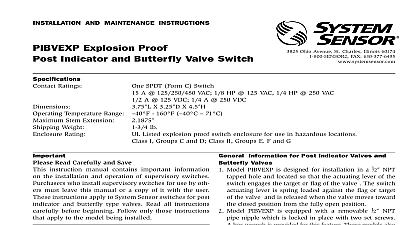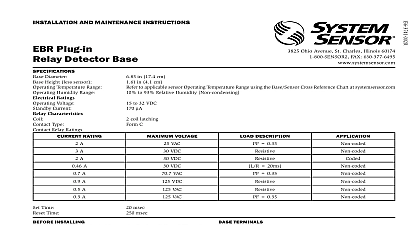System Sensor PIBV2 Manual

File Preview
Click below to download for free
Click below to download for free
File Data
| Name | system-sensor-pibv2-manual-6341892750.pdf |
|---|---|
| Type | |
| Size | 1.35 MB |
| Downloads |
Text Preview
I Ohio Avenue St Charles Illinois 60174 Fax 630.377.6495 2.5 A 24 VDC 125 250 VAC H 31 W 31 D 8.0 cm to 120 0 to 49 lbs Type 3R when mounted with the actuator vertical cover on top as tested by Underwriters Laboratories Inc INSTALLATION CONSIDERATIONS Model PIBV2 is designed for installation in a 1 NPT tapped hole and located that the actuating lever of the switch engages the target or flag of the valve switch actuating lever is spring loaded against the flag or target of the valve is released when the valve moves toward the closed position from the fully position The switch is factory set to indicate an alarm condition when the and lever move in the direction toward the conduit entry hole when the closes but can be reversed if the installation demands refer to Section 4 Model PIBV2 is equipped with a removable 1 NPT pipe nipple which is in place with one set screw A hex wrench is provided for this feature PIBV2 also includes an adjustable length actuating lever The cover is secured with two tamper resistant screws which require a special to remove One key is included with each supervisory switch Replacement additional keys are available Part No WFDW 1 INSTRUCTIONS FOR POST INDICATOR VALVES There are two types of post indicator valves rising flag and falling flag In a flag installation the PIBV2 mounts below the target assembly as shown in 2A Closing the valve raises the target assembly and releases the actuating on the PIBV2 In a falling flag installation the PIBV2 mounts above the assembly Figure 2B Closing the valve lowers the target assembly and the actuating lever on the PIBV2 The PIBV2 is set for falling flag installation If a rising flag operation is desired is necessary to reverse the action of the switch See Section 4 2A RISING FLAG 2B FALLING FLAG AND MAINTENANCE INSTRUCTIONS Post Indicator and Valve Supervisory Switch Ratings Stem Extension Temperature Range Weight Enclosure Rating Patent Number Read Carefully and Save instruction manual contains important information on the installation and op of supervisory switches Purchasers who install supervisory switches for use others must leave this manual or a copy of it with the user These instructions to System Sensor switches for post indicator and butterfly type valves Read instructions carefully before beginning installation NOT use this switch in explosive or potentially explosive atmospheres NOT leave unused wires exposed installing any supervisory switches in sprinkler systems be thoroughly fa with 72 13 25 Installation Maintenance and Use of Local Protective Systems Installation of Sprinkler Systems specifically Section 3.17 Inspection Testing and Maintenance of Sprinkler Systems specifically 4 and 5 1 WFDW SCREW SET SCREW D HEXW H SCREWS ENCLOSURE HOUSING W NUT If the post indicator valve is predrilled with 1 NPT mounting hole remove the and go to step 6 If the post indicator valve is NOT equipped with a 1 mounting hole it will be necessary to drill and tap the hole Position the valve in the fully open position should appear in the and remove the head and target assembly In doing so ensure that the can be reinstalled with its original adjustment a In a falling flag installation flag lowers as valve is closed measure the from the bottom of the head to the upper surface of the target that will the actuating lever of the PIBV2 Add 3 to this measurement and the outside of the housing at that location Drill with a 23 drill bit and a 1 NPT thread b In a rising flag installation flag rises as valve is closed measure the dis from the bottom of the head to the lower surface of the target that will the actuating lever Subtract 3 to this measurement and mark the out of the housing at that location Drill with a 23 drill bit and tap a 1 NPT Replace the head and target assembly Loosen the set screw that holds the nipple on the PIBV2 and remove the Screw the locknut onto the threaded nipple which is supplied with the PIBV2 Screw the nipple hand tight into the 1 hole in the valve and tighten the locknut the housing to secure the nipple in position Insert a probe into the hole through the nipple to measure the distance from the end of the nipple to the desired position on the target assembly Subtract from the distance and set the length of the actuating lever of the PIBV2 from end of the enclosure to this distance Tighten the screw which holds the lever NOTE Place cover over PIBV2 to ensure that actuating lever does not with cover If actuating lever interferes with cover remove lever break off additional length at breakaway point Repeat step 8 to re actuator lever Refer to Figure 7 Close the valve 3 to 4 revolutions Install the PIBV2 onto the nipple and orient the conduit entry down See Figure Apply pressure to the PIBV2 and lock the set screws to secure the nipple to PIBV2 Slowly open the valve to its fully open position The switch should trip as the opens but not force the actuating lever against the nipple when fully To check for this condition open the valve fully and depress the top of actuating cam to stretch the actuating spring further There should be some movement available If no movement is available damage may oc to the PIBV2 actuator lever It will be necessary to adjust the flag location removing the head and turning the handle while the valve stem is disen refer to the valve manufacturer After checking the fully open position to ensure adequate clearance close the slowly until the PIBV2 contacts trip The switches must trip within 1 of full travel distance of the valve If the PIBV2 does not change states within 1 of the length of travel it may be to adjust the flag up or down by removing the head and turning the refer to the valve manufacturer 2 INSTRUCTIONS FOR BUTTERFLY VALVES SEE FIGURE 3 Remove the 1 NPT plug from the valve housing Loosen the set screw that holds the nipple on the PIBV2 and remove the Screw the locknut onto the threaded nipple which is supplied with the PIBV2 Screw the nipple into the 1 NPT hole and hand tighten Tighten the locknut to the housing to secure the nipple Open the valve fully and close the valve approximately 3 revolutions noting direction the target moves Retract the actuating arm and install PIBV2 onto the nipple orienting the to trip the switch as the valve closes If the conduit entry is on the wrong it will be necessary to reverse the action of the switch see Section 4 Ap pressure to PIBV2 and tighten set screw to secure the assembly Slide the actuating arm into the valve until it bottoms on the flag but do not the screw which holds the actuating lever NOTE Place cover over PIBV2 to ensure that actuating lever does not interfere cover If actuating lever interferes with cover remove lever and break off length at breakaway point Refer to Figure 7 Open the valve to the full open position and tighten screw to hold actuating in position Actuating arm length will adjust slightly as valve is opened to ensure that in the full open position the actuating arm is not resting the nipple Do this by depressing the actuating cam to further stretch the ensuring that more travel is available when the valve is open If there is travel damage may occur to PIBV2 actuating arm Some slight alteration of valve stop setting may be necessary to ensure that no damage occurs Carefully close valve and note the number of handle revolutions until the switch The switch must trip within 1 of the total travel range of the valve 3 3 INSTALLATION INSTRUCTIONS 4


